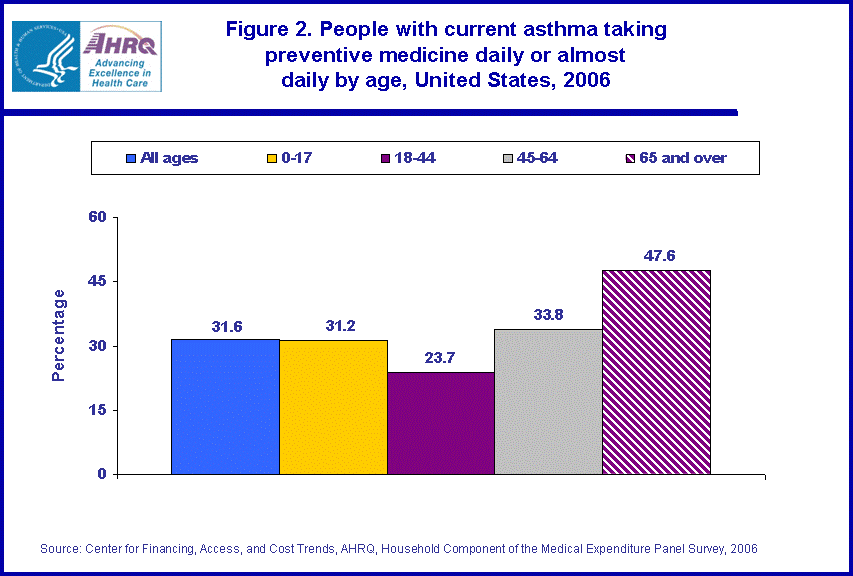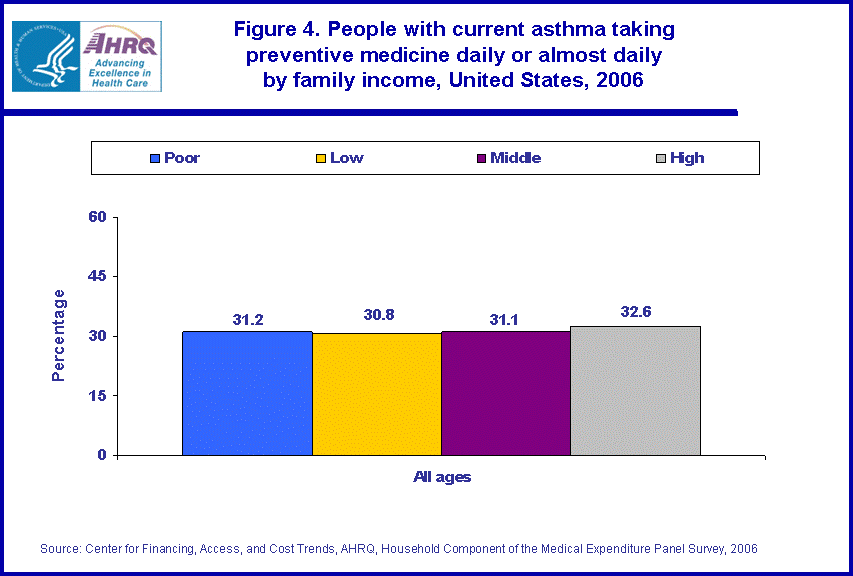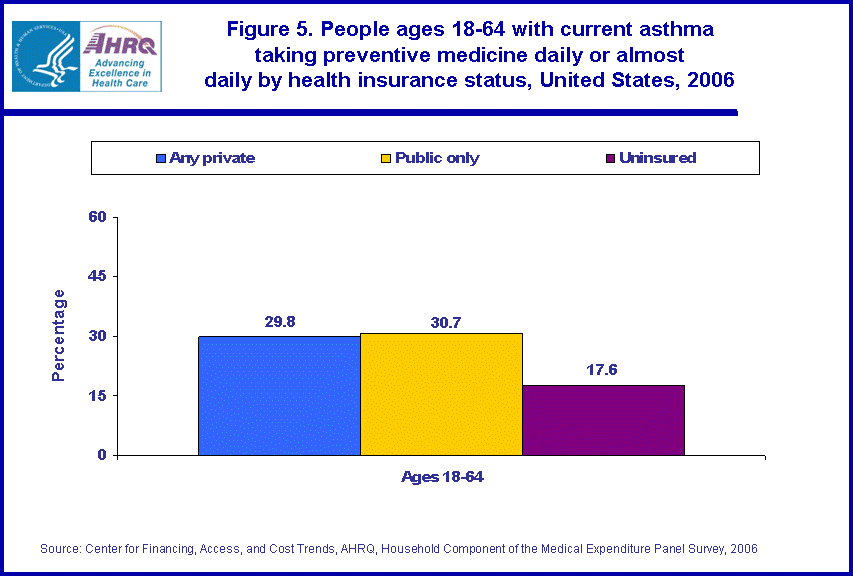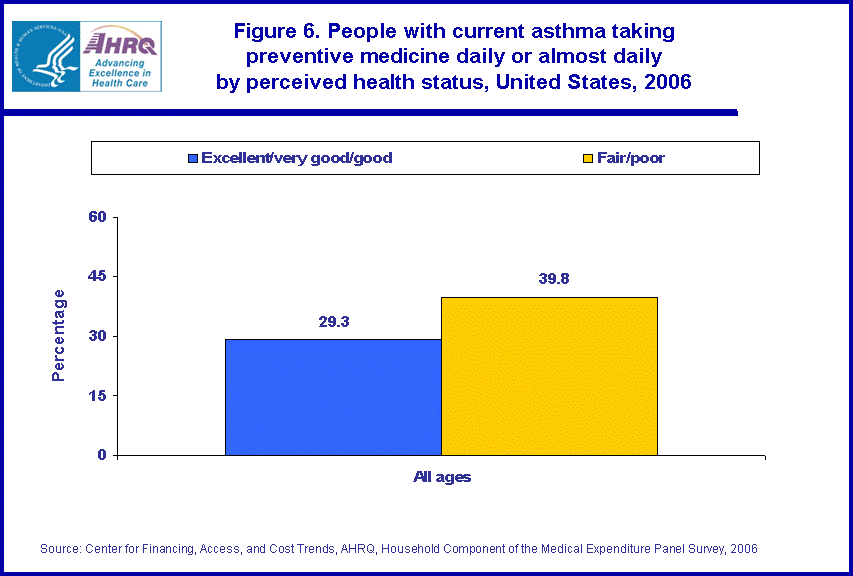
|
|
Font Size:
|
||||
|
|
|
|
||||
STATISTICAL BRIEF #237:
Asthma Preventive Medicine in 2006 -- Who Takes Them?
Highlights
- In 2006, 7.1 percent of the 299.3 million people in the U.S. civilian noninstitutionalized population had current asthma (ever told they had asthma, and reported an attack in the past 12 months or reported still having asthma).
- Of persons with current asthma, those ages 18-44 were less likely than those ages 0-17, 45-64, or 65 and over to be taking asthma daily preventive medicine (23.7 percent vs. 31.2 percent, 33.8 percent and 47.6 percent, respectively).
- White non-Hispanic persons with current asthma were more likely to be taking asthma daily preventive medicine (35.1 percent) than black non-Hispanic persons (25.1 percent), other non-Hispanic persons (25.5 percent), and Hispanic persons (23.2 percent).
- For those under age 65 with current asthma, uninsured persons were about half as likely to be taking asthma daily preventive medicine (17.6 percent) as persons with either any private (29.8 percent) or public only (30.7 percent) health insurance.
Introduction
Asthma is a chronic respiratory disease in which the airways of the lungs become inflamed and constricted. Data from the 2006 Medical Expenditure Panel Survey show that 9.9 percent of the U.S. civilian noninstitutionalized population (29.7 million people) has been told by a doctor or other health professional at some point in their lives that they have asthma. Of these, approximately 33 percent have had an asthma episode during the past 12 months while an additional 39 percent have not had an asthma attack and report they still have asthma (figure 1). Thus, approximately 72 percent of those who have ever been told they have asthma have 'current' asthma. This represents 7.1 percent of the total population.
The treatment of asthma, a chronic respiratory disease, can involve long-term control or preventive medications, quick relief or rescue medications, or allergy medications for allergy-induced asthma. This Statistical Brief presents estimates of the use of daily asthma preventive medicine among those with current asthma for the U.S. civilian noninstitutionalized population in 2006. The estimates are derived from the Household Component of the Medical Expenditure Panel Survey (MEPS-HC).
Unless otherwise indicated, all differences discussed in the text are statistically significant at the .05 level or better.
Findings
In 1996, an estimated 7.1 percent of the U.S. population (approximately 21.2 million people) had 'current' asthma. This means they reported having had an asthma episode during the past 12 months or that they still had asthma.
Asthma daily preventive medicines are often beneficial for the long-term control and management of asthma. In 2006, an estimated 31.6 percent of those with current asthma were taking asthma daily preventive medicines daily or almost every day (figure 2).
Taking asthma daily preventive medicine for persons with current asthma varied according to a number of demographic variables including age, race/ethnicity, and according to health insurance status and health status.
Of persons with current asthma, those ages 18-44 were less likely than those ages 0-17, 45-64, or 65 and over to be taking asthma daily preventive medicine (figure 2). Only 23.7 percent of those 18-44 years of age with current asthma took asthma daily preventive medicine on a daily or almost daily basis compared with 31.2 percent of those ages 0-17, 33.8 percent of those ages 45-64, and 47.6 percent of those aged 65 and over.
White non-Hispanic persons with current asthma were more likely than black non-Hispanic persons, other non-Hispanic persons, and Hispanic persons to be taking asthma daily preventive medicine (figure 3). An estimated 35.1 percent of white non-Hispanic persons with current asthma were taking asthma daily preventive medicine compared with 25.1 percent for black non-Hispanic persons, 25.5 percent for non-Hispanic persons of other or multiple races, and 23.2 percent for Hispanic persons.
Interestingly, the likelihood of persons with current asthma taking asthma daily preventive medicine did not vary significantly by family income status (figure 4). Persons with current asthma who were poor or had low or middle income were not significantly less likely than those with high income to be taking asthma daily preventive medicine (31.2 percent, 30.8 percent, 31.1 percent, and 32.6 percent, respectively).
For persons under age 65, taking asthma daily preventive medicines among those with current asthma varied by health insurance status (figure 5). For those under age 65 with current asthma, uninsured persons are about half as likely to be taking asthma daily preventive medicine as persons with either any private or public only health insurance (17.6 percent vs. 29.8 percent or 30.7 percent, respectively).
The percent of people taking asthma daily preventive medicine among those with current asthma also varied by perceived health status (figure 6). Persons with current asthma reported to be in fair or poor health were more likely (39.8 percent) to be taking asthma daily preventive medicine than persons reported to be in excellent, very good, or good health (29.3 percent).
Data Source
The estimates in this Statistical Brief are based on data from the 2006 Full-Year Consolidated File (HC-105).
Definitions/Methodology
Current asthma status
The determination of current asthma status is based on three separate questions asked in Rounds 3 and 5 of the 2006 survey. Rounds 3 and 5 were administered during the first half of 2006. The first question asks about whether the person has ever been told by a doctor or other health professional that the person has asthma. Persons identified as ever having asthma were asked two additional questions: whether they still have asthma; and, whether they had an episode of asthma or an asthma attack during the past 12 months. Those reported as still having asthma or of having an asthma episode during the past 12 months were classified as currently having asthma.
Taking asthma daily preventive medicine
The determination of whether a person was taking asthma daily preventive medicine is based on two questions in Rounds 3 and 5 asked of people with current asthma. Of persons identified with current asthma a question is asked about whether the person has ever taken the preventive kind of asthma medicine used every day to protect their lungs and keep them from having attacks. Of those answering yes, a second question is asked about whether the person is now taking this medication daily or almost daily.
Age
For this report age refers to age at the time of the Rounds 3 and 5 interviews (rounds in which the asthma questions were asked).
Race/ethnicity
Classification by race/ethnicity in this report is based on the following four race/ethnicity groups: Hispanic; black single race non-Hispanic; white single race non-Hispanic; and other races non-Hispanic. Classification by race and ethnicity is based on information reported in MEPS for each family member. First, respondents were asked if the person's main national origin or ancestry was Puerto Rican; Cuban; Mexican, Mexican American, or Chicano; other Latin American; or other Spanish. All persons whose main national origin or ancestry was reported as one of these Hispanic groups, regardless of racial background, were classified as Hispanic. All other persons were classified according to their reported race. The other non-Hispanic category includes non-Hispanics of other races or multiple races.
Family income status
Personal income from all family members within a household was summed to create family income. Based on the ratio of family income to the federal poverty thresholds, which vary with family size and age of the head of the family, categories are defined as follows:
- Poor: Persons in families with income less than 100 percent of the poverty line, including those who reported negative income.
- Low income: Persons in families with income from 100-199 percent of the poverty line.
- Middle income: Persons in families with income from 200-399 percent of the poverty line. High income: Persons in families with income of at least 400 percent of the poverty line.
Individuals under age 65 were classified in the following three insurance categories, based on household responses to health insurance status questions:
- Any private health insurance: Individuals who, at any time during the year, had insurance that provides coverage for hospital and physician care (other than Medicare, Medicaid, or other public hospital/physician coverage) were classified as having any private health insurance. Coverage by TRICARE (Armed Forces-related coverage) was also included as private health insurance. Insurance that provides coverage for a single service only, such as dental or vision coverage, was not included.
- Public coverage only: Individuals were considered to have public coverage only if they met both of the following criteria: 1) they were not covered by private insurance at any time during the year, and 2) they were covered by any of the following public programs at any point during the year: Medicare, Medicaid, or other public hospital/physician coverage.
- Uninsured: The uninsured were defined as people not covered by any private hospital/physician insurance, Medicare, TRICARE, Medicaid, or other public hospital/physician programs at any time during the entire year or period of eligibility for the survey.
For this report, health status refers to health status at the time of the Rounds 3 and 5 interviews. Respondents were asked to rate the health of each person in the family according to the following categories: excellent, very good, good, fair, and poor. The categories were combined into two groups: excellent, very good, or good; and, fair or poor.
About MEPS-HC
The MEPS Household Component (MEPS-HC) is a nationally representative longitudinal survey that collects detailed information on health care utilization and expenditures, health insurance, and health status, as well as a wide variety of social, demographic, and economic characteristics for the U.S. civilian noninstitutionalized population. It is cosponsored by the Agency for Healthcare Research and Quality and the National Center for Health Statistics.
For more information about MEPS, call the MEPS information coordinator at AHRQ, (301) 427-1656 or visit the MEPS Web site at http://www.meps.ahrq.gov/.
References
For a detailed description of the MEPS-HC survey design, sample design, and methods used to minimize sources of nonsampling error, see the following publications:
Cohen, J. Design and Methods of the Medical Expenditure Panel Survey Household Component. MEPS Methodology Report No. 1. AHCPR Pub. No. 97-0026. Rockville, MD: Agency for Health Care Policy and Research, 1997. http://www.meps.ahrq.gov/mepsweb/data_files/publications/mr1/mr1.shtml
Cohen, S. Sample Design of the 1996 Medical Expenditure Panel Survey Household Component. MEPS Methodology Report No. 2. AHCPR Pub. No. 97-0027. Rockville, MD: Agency for Health Care Policy and Research, 1997. http://www.meps.ahrq.gov/mepsweb/data_files/publications/mr2/mr2.shtml
Cohen SB. Sample Design of the 1997 Medical Expenditure Panel Survey Household Component. Rockville (MD): Agency for Healthcare Research and Quality, 2000. MEPS Methodology Report No. 11, AHRQ Pub. No. 01-0001. http://www.meps.ahrq.gov/mepsweb/data_files/publications/mr11/mr11.pdf
Cohen, SB. Design Strategies and Innovations in the Medical Expenditure Panel Survey. Medical Care, July 2003: 41(7) Supplement: III-5-III-12.
Suggested Citation
Chevarley, F.M. Asthma Preventive Medicine in 2006 -- Who Takes Them? Statistical Brief #237. March 2009. Agency for Healthcare Research and Quality, Rockville, MD. http://www.meps.ahrq.gov/mepsweb/data_files/publications/st237/stat237.pdf
AHRQ welcomes questions and comments from readers of this publication who are interested in obtaining more information about access, cost, use, financing, and quality of health care in the United States. We also invite you to tell us how you are using this Statistical Brief and other MEPS data and tools and to share suggestions on how MEPS products might be enhanced to further meet your needs. Please e-mail us at MEPSPD@ahrq.gov or send a letter to the address below:
Steven B. Cohen, PhD, Director
Center for Financing, Access, and Cost Trends
Agency for Healthcare Research and Quality
540 Gaither Road
Rockville, MD 20850
 |
||||||||||||||||
|
||||||||||||||||
|
|
||||||||||||||||
 |
||||||||||||||||
|
||||||||||||||||
|
|
||||||||||||||||
 |
||||||||||||||||
|
||||||||||||||||
|
|
||||||||||||||||
 |
||||||||||||||||
|
||||||||||||||||
|
|
||||||||||||||||
 |
||||||||||||||||
|
||||||||||||||||
|
|
||||||||||||||||
 |
||||||||||||||||
|
||||||||||||||||
|
|
||||||||||||||||


